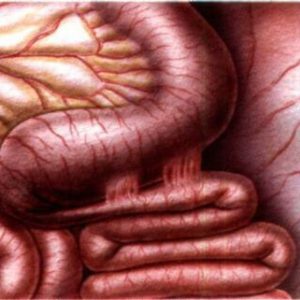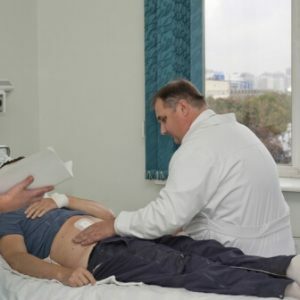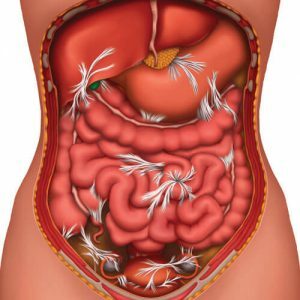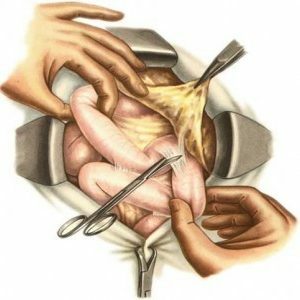Adhesive disease of the abdominal cavity organs

Constant "companion" of any surgical interventions in the abdominal cavity is a commissural disease.It can be asymptomatic, or give a person a pronounced discomfort - it all depends on the severity of the course and the prevalence of the pathological process.There are surgeons who are sure that adhesions occur in 100% of cases of operations in the abdominal cavity, but in some cases they subsequently dissolve themselves.
Rare, but there may be a congenital adhesion process that occurs in newborns who are not subjected to any surgical interventions.Recently, there has been an increase in the cases of diagnosis of adhesions of the abdominal organs after laparoscopy.
Table of contents: How the adhesive disease develops The causes of the development of adhesive disease of the abdominal cavity Symptoms of adhesive disease of the abdominal organs Treatment of adhesive disease of the abdominal organs Prevention measuresHow the adhesion develops
 The abdominal organs are covered by the peritoneum, which has the ability to delineate areasDamage.For example, if there is an untreated appendicitis, the peritoneum literally adheres to the area of inflammation, forming a limited cavity( appendicular infiltrate).Precisely such process of adhesion occurs and at operative interventions, that is the peritoneum can stick to places of a cut, a zone of an inflammation or the operated organ.
The abdominal organs are covered by the peritoneum, which has the ability to delineate areasDamage.For example, if there is an untreated appendicitis, the peritoneum literally adheres to the area of inflammation, forming a limited cavity( appendicular infiltrate).Precisely such process of adhesion occurs and at operative interventions, that is the peritoneum can stick to places of a cut, a zone of an inflammation or the operated organ.
If there is a chronic inflammation in the abdominal cavity, or the inflammatory process has spread too much to the organs, the peritoneum is glued immediately to all organs.Thus, there is a violation of their location and normal functioning.As the pathological process progresses, the adhesions become denser and shorter, actively displacing and surviving the organs and tissues that have entered them.Against the backdrop of such an aggressive / negative impact on the internal organs of the abdominal cavity, the vessels that feed tissues and organs are squeezed, and the result is a violation of blood flow and the development of oxygen starvation in the organs.In addition, if the adhesion process affected the intestine, then as the pathology progresses, the movement of stool masses is disrupted, and this is a harbinger of intestinal obstruction.
Note: in the international classification of diseases there is a division of adhesive disease of the organs of the abdominal cavity and the adhesive disease of the small pelvis.But in fact, this is one disease, since the small pelvis is part of the abdominal cavity.The reason for the allocation of pathology in the small pelvis is that it is there that the female internal genital organs are located, namely, they are most often subjected to adhesions.
Causes of development of adhesive disease of the abdominal cavity
In general, there are a lot of reasons for the development of this disease, but the doctors identified several main groups:
- Mechanical injuries of the abdominal cavity.The following are implied:
- stab wounds;
- surgical operations;
- falling on a solid object;
- falls from height;
- blows;
- bullet wounds.
- Chemical Damage.This group includes:
- rupture of the gallbladder with the outflow of bile into the abdominal cavity;
- perforation of the stomach( eg, with peptic ulcer disease) with mandatory release of acidic contents;
- burns with alkalis and acids( can be for accidental or intentional use);
- pancreatitis, taking place in severe form with pancreatic enzymes discharging through the abdominal cavity.
- Inflammatory diseases.Adhesive disease can develop against a background of cholecystitis, colitis( inflammation of the large intestine), appendicitis, enteritis( inflammation of the small intestine), salpingitis or oophoritis( inflammation of the fallopian tubes and appendages).
 It is quite often that the inflammatory process in the female genital organs contributes to the development of adhesive disease.Adhesive process of this type of development, as a rule, is asymptomatic, so the pathology develops quickly, deeply, is not treated and the result is female infertility.
It is quite often that the inflammatory process in the female genital organs contributes to the development of adhesive disease.Adhesive process of this type of development, as a rule, is asymptomatic, so the pathology develops quickly, deeply, is not treated and the result is female infertility.
There are three factors that can trigger the development of the pathological process under consideration - diabetes mellitus, a violation of diet / diet and foreign bodies in the wound.
Symptoms of adhesive disease of the abdominal cavity
Physicians describe the clinical picture of the disease in total in four words:
- vomiting;
- abdominal pain;
- flatulence;
- constipation.
Of course, these symptoms do not manifest all at once - depending on where the adhesion process is located, there will be various combinations of symptoms.In some cases, for example, with adhesions of the internal genital organs in women, the disease does not manifest itself at all and is found out by accident.
Abdominal pain occurs with the development of adhesive disease of the intestine, because when squeezing with adhesions, bleeding of the gut region occurs.At the same time, the intestine does not immediately "give up," but peristals and tries to fight the problem.Pain in the abdomen with adhesive disease is always prolonged, because the squeezing of the organ occurs gradually - first the pain is dull / aching, then it becomes sharp / cutting.Patients describe their feelings in different ways: for some, pain has a clear localization, for many, these unpleasant sensations are "poured" throughout the stomach.
Please note: if intensive care in the abdomen does not provide qualified medical care, then the patient's condition will be normal after a while.But this does not mean that the disease has receded!This completely destroyed the nerve endings and irreversible processes began in the damaged organ.
But even with the disappearance of the pain syndrome the intestine continues to work, but there is no progression of feces.This condition is always accompanied by constipation, vomiting and flatulence.It is noteworthy that if the pathological process under consideration develops in the small intestine, then the first symptom will be vomiting - abundant, multiple, with the content of bile, intestinal and gastric juice.Vomiting does not alleviate the patient's condition at all, the feeling of heaviness in the abdomen does not disappear, every attack is accompanied by intense pain in the intestines, and nausea does not stop even for a minute.
 If the adhesion develops in the large intestine, then the first symptom is constipation.The problem is that this syndrome often disturbs a person even in the absence of a commissural disease and in most cases the patient simply does not pay any attention to him.But after all, spikes are increasingly shortening and entangle the intestines, which leads to a violation of its functionality.Fecal masses do not leave, remain in the intestines and begin to wander.This process ends with the formation of a large number of gases that also do not have an outlet - the stomach swells, the bowels stretch, and the person experiences severe pain.
If the adhesion develops in the large intestine, then the first symptom is constipation.The problem is that this syndrome often disturbs a person even in the absence of a commissural disease and in most cases the patient simply does not pay any attention to him.But after all, spikes are increasingly shortening and entangle the intestines, which leads to a violation of its functionality.Fecal masses do not leave, remain in the intestines and begin to wander.This process ends with the formation of a large number of gases that also do not have an outlet - the stomach swells, the bowels stretch, and the person experiences severe pain.
Note: for adhesions of the large intestine neither enemas nor any medications with a laxative effect do not bring relief to the patient.Such procedures can even worsen the situation.
This pathological condition can develop in the pelvic organs and in this case the symptoms of adhesion will be somewhat different.First, a woman begins to break the menstrual cycle, which is expressed in irregular and painful bleeding.Secondly, a woman can pay attention to the presence of mild pain during and after sexual intercourse.Such a pathological condition requires immediate application for qualified medical care, as the probability of infertility is high.
Treatment of adhesive disease of the abdominal cavity
It should be pointed out immediately that the doctors are taking all possible preventive measures even at the stage of surgical interventions on the abdominal organs. These specialist actions are called preventive treatment of adhesive disease:
- during surgery use polymer icodextrin( 4% solution);
- creation around the intestine of a gel-like barrier with polyethylene oxide and carboxymethyl cellulose;
- application of barrier membranes with hyaluronic acid, cellulose or other materials.
 The peculiarity of the considered disease lies in the fact that it can develop in a remote period after surgery.If symptoms of an adhesive disease of the abdominal cavity appeared, then in no case can you delay!No folk methods, massages, enemas and other home remedies will not help, although they can bring some relief.But in the pursuit of a fast "cure" time is lost, spikes are rapidly developing and cause irreparable harm to the organs.
The peculiarity of the considered disease lies in the fact that it can develop in a remote period after surgery.If symptoms of an adhesive disease of the abdominal cavity appeared, then in no case can you delay!No folk methods, massages, enemas and other home remedies will not help, although they can bring some relief.But in the pursuit of a fast "cure" time is lost, spikes are rapidly developing and cause irreparable harm to the organs.
Treatment of adhesive disease of the abdominal cavity is performed exclusively by surgical method.
Preventative measures
If you analyze all the data on adhesions of the abdominal organs, it can be concluded that it is impossible to prevent the development of the pathological process under consideration.And in part this is true, but there are also non-surgical causes of the development of adhesions, which are really preventable.
For example, if you follow certain rules, you can significantly reduce the risk of developing a commissural disease in the small pelvis .These rules include:
- Appendicitis, acute pancreatitis, cholecystitis and peritonitis are not treated with folk remedies!You should not even "google" in search of the most effective herbal decoction / infusion - these diseases are treated only in the inpatient department of a medical institution by a surgeon.
- If chronic inflammatory diseases of the abdominal cavity are present, they should also be treated under the strict supervision of a physician.Yes, in some cases it is permissible to use funds from the category "traditional medicine", but first you need to consult your doctor.
- It is necessary to monitor their sexual health:
- use barrier methods of contraception;
- visit the doctor regularly for examination of the pelvic organs;
- observe the rules of personal hygiene;
- periodic screening for sexually transmitted infections;
- timely and competent treatment of pathologies of female genital organs.
Adhesive disease of the abdominal cavity is a dangerous pathology that can lead not only to loss of health, but also to death.Only timely diagnostics and competent treatment will help to avoid the most terrible, restore the functionality of damaged organs.
Tsygankova Yana Aleksandrovna, medical reviewer, therapeutist of the highest qualification category



